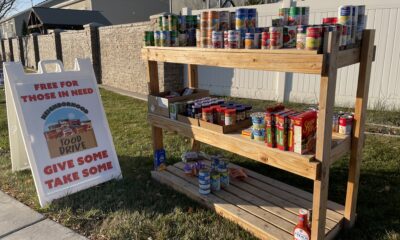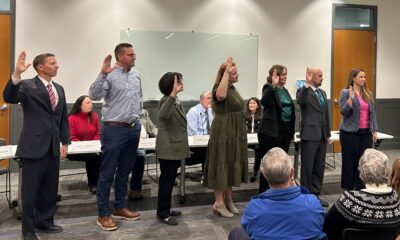Connect with us
Published
3 weeks agoon

April Slaughter | Lehi Free Press
The federal government shutdown that began on October 1, 2025, has had immediate and tangible consequences for families who rely on Supplemental Nutrition Assistance Program (SNAP) benefits. By November 1, many recipients saw their monthly benefits delayed or paused as federal appropriations lapsed and agencies, courts, and states scrambled to determine whether contingency funds could be used to reload Electronic Benefits Transfer (EBT) accounts.
SNAP serves a large and diverse population, roughly 42 million people nationwide, including about 16 million children, and requires billions in monthly funding to meet demand. Because SNAP funds come from the federal government and are routed through state agencies, any lapse in federal appropriations interrupts the flow of funds that households depend on, even though states manage eligibility and distribution.
This disruption exposed a persistent and harmful misconception: that most SNAP recipients are “lazy,” unemployed and unwilling to work. The reality is far more complex. Many SNAP households include at least one working adult, often in low-wage, part-time, or unstable jobs in sectors like retail, hospitality, caregiving, and agriculture. These jobs are often low-paying and offer unreliable hours. Other SNAP recipients are seniors on fixed incomes, people with disabilities, veterans, students, single parents, or unpaid caregivers. While work requirements exist within SNAP, they intersect with caregiving needs, medical conditions, and local job markets—making benefits essential for people who are employed but underpaid, or temporarily unable to work.
Legal challenges and administrative decisions regarding SNAP payments in early November produced a patchwork of outcomes. Federal courts in some jurisdictions ordered the U.S. Department of Agriculture to use contingency funds to continue payments, and the administration released a $4.65 billion allocation intended to cover part of November’s benefits. Still, implementing any payment plan required coordination at multiple levels, resulting in partial or delayed disbursements. Some households received staggered aid while others waited longer, creating inequities across states and counties in the absence of a unified solution.
Utah, like other states, does not have a funding mechanism to simply replace federal SNAP benefits for its residents. Although the state could theoretically use its general fund or pass emergency appropriations, leaders chose not to fully backfill monthly benefits. State officials cited concerns that spending might not be reimbursed, the high cost of covering the entire caseload, and the risk of setting an unsustainable precedent. At the time of the funding lapse, an estimated 140,000 Utahns (roughly 86,000 households) were affected. Instead of issuing full replacements, the state provided targeted support, most notably a one-time allocation of up to $4 million for food banks—while awaiting further federal guidance, legal outcomes, and congressional action.
The human consequences were swift and predictable. Food banks and emergency feeding networks reported surging demand as families exhausted savings and scrambled to buy groceries. Emergency donations and short-term help can’t replace SNAP’s regular monthly aid.
Legal briefs and media outlets warned of irreparable harm to families who depend on those benefits to bridge paychecks, cover bills, and feed their children. For those living paycheck to paycheck or without access to credit, even a short interruption in SNAP can mean skipped meals, missed utility payments, and worsening health and educational outcomes.
Over the weekend, federal officials came together to announce some compromises to reopen the government. But this will take time, and if the shutdown continues much longer, the outlook darkens: further delays, more profound food insecurity, greater strain on nonprofits, and growing pressure on state budgets if local leaders attempt to intervene. Different state responses have already produced geographic inequities: two families with the same circumstances can end up with wildly different outcomes simply because of where they live.
Restoring SNAP’s dependability requires action from Congress; without dedicated appropriations, piecemeal court orders and emergency funding only extend uncertainty and add administrative strain.
Calling SNAP recipients lazy overlooks the real struggles behind their need for assistance. The program supports people with low pay, unpredictable employment, caregiving duties, medical challenges, and abrupt financial setbacks. SNAP isn’t a handout; it’s a federal safety net that helps families feed their children while they work, look for work, or manage crises. Blaming recipients for a breakdown in federal policy distracts from lawmakers’ decisions that created the situation and stigmatizes people who are already vulnerable.
For journalists, policymakers, and the public, the imperative is both practical and moral: report accurately on who SNAP serves, resist reductive narratives, and advocate for solutions that restore timely benefits. Support for neighborhood food systems and the voices of those hurt by benefit gaps should be a priority, so decision-makers grasp the human toll. Congress must act to reinstate funding — otherwise millions of families will keep paying the price of a political impasse that now reads as a food‑security emergency.



Dan Peterson School students shine in annual wax museum project


New team alters the Region 3 swimming landscape; Soderquist claims silvers for Lehi


Over the years, many structures accommodated Lehi students


Falcon girls 3rd and boys 4th at Region 3 swim meet as new teams enter the mix


Toy and clothing drive brings hope this Christmas


Historic home welcomes new craft and gift shop, Makers & Co.


Thanksgiving: it’s all about food and memories


Discover the magic of giving this Giving Tuesday


Aspen Peaks School Board members sworn in at historic ceremony, Lehi’s Diane Knight to be board president


District choir students end intense training day with concert
